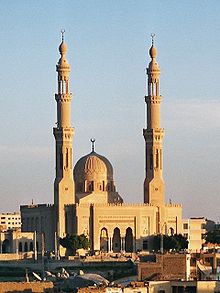Minaret
Minaret or minaret are the names given in Spanish to the Arabic word منار (minar or manār), which designates each of the towers of the Muslim mosques.
Both names come from Arabic: the first directly into Spanish with the addition of the Arabic article al-, and the second from French minaret, taken from Turkish, minare, which in turn takes it from Arabic. The Arabic word minar actually means "lighthouse", because in centuries past it was common to place lights on the minarets to guide travelers towards the city. In Arabic, the word that more properly designates this part of the mosque is مئذنة mi'dhana, that is, the place from where the adhan or call to prayer is made. prayer; for its ritual function is to provide an elevated environment for the muezzin or muezzin (مُؤَذِّن mu'aḏḏin -"cryer"-) to make the five calls (أَذَان adhan ) that are made every day to call for prayer (صلاة salat). For this, the minaret usually has a balcony that surrounds it at its highest part, from which the call is made. At present, the muezzin is usually helped by a public address system so that it can be heard more easily in large cities.
Domination of space
The function of the minaret is also to mark the physical, visual and sound domination of the space. There is a wide variety of styles of minarets in the world.
When the Turks turned Hagia Sophia into a mosque, they surrounded the immense mass of the dome that characterized the city's skyline with four minarets. Similarly, the Spanish Reconquista Christianized the minarets, turning them into church towers that rose above the mosques.
Shape and number
The shape and number of the minarets varies according to the zones:
In the Muslim East, mosques with more than one are common, generally two or four, and in a variable way. Characteristic in places of Ottoman influence are the slender minarets with a circular section, with a protruding balcony and a conical roof. The number of minarets is also significant: when Sultan Ahmed I had six minarets erected in Istanbul's Blue Mosque, he was criticized because until then it had only had that number Masjid al-Haram (" the holy mosque of Mecca, where the Kaaba is kept); the sultan solved the problem by having a seventh minaret built in Mecca.
In the Maghreb, mosques usually have only one, with a square floor plan.
Malwiyya, the minaret of the mosque of Samarra (Iraq), an ascending spiral, is distantly inspired by the shape of the ziggurat; and influenced that of the Ibn Tulun Mosque in Cairo.
Timbuktu is characterized by minarets made of earth, straw and wood, three of which (together with their mosques-madrasa) have been declared World Heritage Sites by UNESCO (Sankore, Djinguereber and Sidi Yahya).
Throughout the world we can find many other and diverse types of minarets from different artistic currents and from different historical periods
Contenido relacionado
Shiva
First epistle to the corinthians
Jerusalem


















